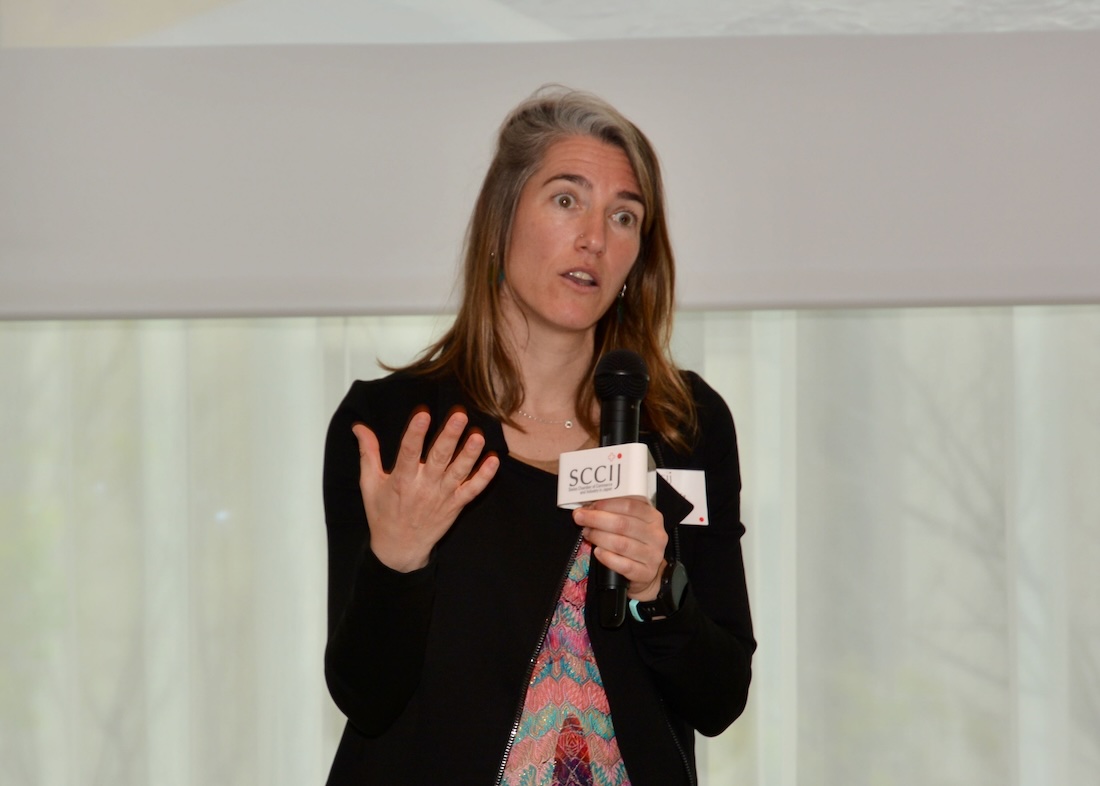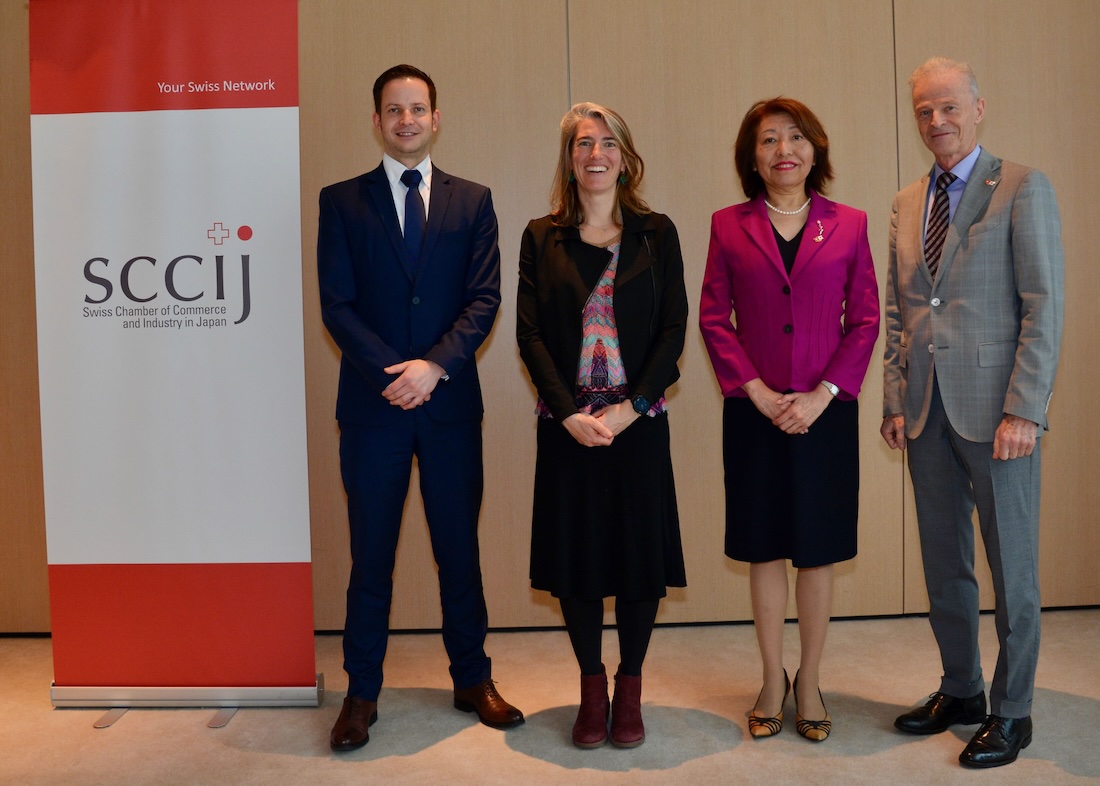Tokyo (SCCIJ) – A Swiss team in collaboration with US and Japanese scientists is conducting an in-depth independent study on the ongoing release of radionuclides from the Fukushima Daiichi nuclear power plant into the Pacific Ocean. At the April Luncheon with more than 40 members and guests of the SCCIJ, team leader Professor Dr. Núria Casacuberta Arola of the Swiss Federal Institute of Technology in Zurich (ETHZ) presented the project and an up-to-date of the results obtained in the last 13 years. We present her speech in Q&A form.

SCCIJ April Luncheon Speaker Professor Dr. Núria Casacuberta Arola of the Swiss Federal Institute of Technology in Zurich.
Why is one of the two top universities of Switzerland, a landlocked European nation, involved in research about radionuclides in the ocean, in particular off the coast of Fukushima?
Prof. Dr. Núria Casacuberta Arola: My involvement with Fukushima goes back to my postdoctoral research in Barcelona, where we optimized a method to measure one of the radionuclides that were released into the ocean in 2011, namely Strontium-90. The reason why Switzerland is involved in this study is because in 2013, I earned an ETH postdoctoral fellowship and continued the monitoring activities of radionuclides in the ocean, at ETHZ. In particular, we expanded to the long-lived radionuclides Iodine-129, Plutonium-239, Plutonium-240, Carbon-14, and Uranium-236. These radionuclides can only be measured using very sophisticated machines, known as Accelerator Mass Spectrometers (AMS), that can detect very small traces of radionuclides in ocean water.
But why does this monitoring project take place in Switzerland?
N. Casacuberta: An excellent question. The reason is that Zurich is the mecca of AMS. Samples collected offshore Fukushima are sent to ETHZ, where we process them in the lab and finally count them with AMS machines located in the Laboratory of Ion Beam Physics. Due to the existence of these mass spectrometers and our Swiss expertise in using radionuclides as ocean tracers, we have established an extensive institutional network of scientific organizations to collaborate in this field of ocean studies.

April Luncheon Speaker Professor Dr. Núria Casacuberta Arola of ETHZ with SCCIJ President Thomas Brodbeck, Executive Committee Member Naoko Koyama and former SCCIJ President Andre Zimmermann (from left).
And how did you personally become engaged in the Fukushima aftermath research?
N. Casacuberta: Shortly after defending my PhD thesis in February 2011, the Fukushima nuclear disaster struck Japan. Experts were needed to join an international team of scientists, spearheaded by Dr. Ken Buesseler of Woods Hole Oceanographic Institution, and my former PhD advisor Prof. Dr. Pere Masqué (Autonomous University of Barcelona) offered me this great opportunity. A team of about 15 scientists onboard an old research vessel from the University of Hawaii investigated the extensive radioactive releases into the Pacific Ocean. This experience ignited my passion for oceanic exploration and the application of radioactive tracers to unravel the mysteries of the oceans, for example, how climate change influences ocean circulation in the Arctic and North Atlantic oceans.
The first research expedition after the accident was followed by several more almost annually until 2022. Can you sum up your overall findings?
N. Casacuberta: The data we have been producing in the last 13 years show that the levels of all radionuclides we analyzed (Caesium-137, Strontium-90, Iodine-129, etc.) went back to the levels before the nuclear accident in 2011. The radioactive impact of the accident on the Pacific Ocean near the Fukushima plant is over.

The SCCIJ April Luncheon at the Tokyo Edition Toranomon was fully booked.
If we are back to “normal”, what is your current research project about?
N. Casacuberta: The reason to be back in Japan is related to the release of the treated radioactive wastewater stored in tanks on the ground of the nuclear power plant into the Pacific Ocean. Japan’s Nuclear Regulatory Authority approved my project plan in May 2022, and at the end of 2022, I received an ETH Research Grant worth 287,000 Swiss francs for a project entitled “Fukushima Revival: quantifying new (and old) sources of radionuclides in the Pacific Ocean”. This project will last until 2026.
Your first project mission just happened before our luncheon talk.
N. Casacuberta: Indeed, only two weeks ago we used the research vessel Shinsei Maru to do two types of fieldwork. The first consists of taking samples at sea, close to the Fukushima Dai-ichi nuclear power plant and especially close to the discharge outlet, using a CTD rosette equipped with 24 bottles of 12-liter capacity, that are deployed at different depths. Samples of fish, phytoplankton, and zooplankton are collected using different types of nets. Finally, sediment samples from the seabed are collected using a multi-core sampler. The second type of fieldwork takes place at beaches south of Iwaki (in Fukushima prefecture). Two beaches were contaminated after 2011 and levels of Caesium-137 and Iodine-129 and levels at the underneath the sand beaches stayed quite high at least until 2018.
Why is this research necessary? Tepco itself provides data about the tritium (and other radionuclides) in the Pacific Ocean water after each release.
N. Casacuberta: The main concern about these releases of treated and heavily diluted radioactive wastewater is about one of the radionuclides present in all tanks: tritium. Numbers published by Tepco show that the highest levels of tritium measured at the discharge point are only about 25 becquerel per liter, way below the regulatory limit. Although high efforts are made to keep the public informed about the tritium releases to the ocean, we still want to monitor this and other radionuclides that are more bioavailable than tritium and could accumulate in sediments and fish (e.g. Strontium-90, Caesium-137, Iodine-129, Carbon-14, Technetium-99, Plutonium-239).
How dramatic is the situation regarding tritium in the water?
N. Casacuberta: The concentration of tritium discharged into the Pacific Ocean is low, posing no radiological concern. Tepco has established a threshold for the emission of tritium at 22 terabecquerel (TBq) annually, significantly below the quantities released by other nations into the ocean. Tritium, a byproduct of nuclear power generation, has been discharged to the Atlantic Ocean since the 1970s by two European nuclear-reprocessing plants of Sellafield (UK) and La Hague (France). Since the 1990s, La Hague has been discharging about 10,000 TBq per year into the English Channel, a magnitude roughly 450 times greater than Tepco’s planned discharge. Attention should not solely focus on Fukushima; rather, other nations releasing radionuclides into the ocean should also be considered. Nonetheless, our mission as scientists is to generate valuable data and foster trust within society.
About the speaker
Professor Dr. Núria Casacuberta Arola obtained her Bachelor’s degree in Environmental Sciences from the Autonomous University of Barcelona, where she also completed her Master’s and PhD studies. In 2013, she was awarded a postdoctoral fellowship from ETH, followed by another fellowship from the Swiss National Science Foundation in 2015, enabling her to further her scientific endeavors in Zürich. In 2020, she received two prestigious grants (SNF PRIMA and ERC Consolidator), facilitating her ongoing research on utilizing long-lived radionuclides to elucidate ocean circulation patterns and monitor changes in the Arctic and North Atlantic oceans.
Text and pictures: Martin Fritz for SCCIJ





























